Venezuelan bolívar: Difference between revisions
| Line 34: | Line 34: | ||
The Central Bank of Venezuela is promoting the new currency with an ad campaign and the slogan: "''Una economía fuerte, un bolívar fuerte, un país fuerte''" (lit. "a strong economy, a strong bolívar, a strong country").<ref name=autogenerated1 /> Nevertheless, the black market value of the ''bolívar fuerte'' has been significantly lower than the [[fixed exchange rate]] of 2.15 (in February 2008 it was as high as 7.0 to 1).<ref name=NYT_Feb08/> It is illegal to publish this "parallel exchange rate" in Venezuela.<ref name=NYT_Feb08/> |
The Central Bank of Venezuela is promoting the new currency with an ad campaign and the slogan: "''Una economía fuerte, un bolívar fuerte, un país fuerte''" (lit. "a strong economy, a strong bolívar, a strong country").<ref name=autogenerated1 /> Nevertheless, the black market value of the ''bolívar fuerte'' has been significantly lower than the [[fixed exchange rate]] of 2.15 (in February 2008 it was as high as 7.0 to 1).<ref name=NYT_Feb08/> It is illegal to publish this "parallel exchange rate" in Venezuela.<ref name=NYT_Feb08/> |
||
Some estimations suggest that the government spent more than US$320,000,000 to introduce the new currency. |
Some estimations suggest that the government spent more than US$320,000,000 to introduce the new currency.{{Citation needed|date=January 2012}}} |
||
At 8 January 2010, the value was changed by the government from the fixed exchange rate of 2.15 bolívares fuertes to 2.60 bolívares for some imports (certain foods and healthcare goods) and 4.30 bolívares for other imports like cars, petrochemicals, and electronics.<ref>{{cite news|publisher=[[BBC]]|url=http://news.bbc.co.uk/2/hi/business/8449721.stm |title=Venezuela will slash value of currency, the bolivar |accessdate=2010-01-09 | date=2010-01-09}}</ref> |
At 8 January 2010, the value was changed by the government from the fixed exchange rate of 2.15 bolívares fuertes to 2.60 bolívares for some imports (certain foods and healthcare goods) and 4.30 bolívares for other imports like cars, petrochemicals, and electronics.<ref>{{cite news|publisher=[[BBC]]|url=http://news.bbc.co.uk/2/hi/business/8449721.stm |title=Venezuela will slash value of currency, the bolivar |accessdate=2010-01-09 | date=2010-01-09}}</ref> |
||
Revision as of 11:20, 4 January 2012
| Bolívar fuerte venezolano Template:Es icon | |
|---|---|
| ISO 4217 | |
| Code | VEF |
| Unit | |
| Plural | bolívares fuertes |
| Symbol | Bs.F.[1] or Bs. |
| Nickname | bolo(s), luca(s) |
| Denominations | |
| Subunit | |
| 1/100 | céntimo |
| Banknotes | Bs.F. 2; 5; 10; 20; 50; 100[1] |
| Coins | Bs.F. 0.01; 0.05; 0.10; 0.12½; 0.25; 0.50; 1[1] |
| Demographics | |
| User(s) | |
| Issuance | |
| Central bank | Banco Central de Venezuela |
| Website | www.bcv.org.ve |
| Valuation | |
| Inflation | +22.9% (May 2011) [2] |
| Pegged with | U.S. dollar = Bs.F. 4.30 (Greatly different black market rate; see article text)[3] |
The bolívar fuerte (sign: Bs.F.[1] or Bs.;[citation needed] plural: bolívares fuertes; ISO 4217 code: VEF) is the currency of Venezuela since 1 January 2008. It is subdivided into 100 céntimos[4] and replaced the bolívar (sign: Bs.;[1] plural: bolívares; ISO 4217 code: VEB) at the rate of Bs.F. 1 = Bs. 1,000 due to inflation.
History
Bolívar
The bolívar was adopted by the monetary law of 1879, replacing the short-lived venezolano at a rate of five bolívares to one venezolano. Initially, the bolívar was defined on the silver standard, equal to 4.5g fine silver, following the principles of the Latin Monetary Union. The monetary law of 1887 made the gold bolívar unlimited legal tender, and the gold standard came into full operation in 1910. Venezuela went off gold in 1930, and in 1934 the bolívar exchange rate was fixed in terms of the U.S. dollar at a rate of 3.914 bolívares = 1 U.S. dollar, revalued to 3.18 bolívares = 1 U.S. dollar in 1937, a rate which lasted until 1941. Until 18 February 1983 (now called Black Friday (Viernes Negro)[5] by many Venezuelans, the bolívar had been the region's most stable and internationally accepted currency. It then fell prey to high devaluation. Exchange controls were adopted since February 5, 2003 to limit capital flight,[6] pegged to the U.S. dollar at a fixed exchange rate of 1600 VEB to the dollar.
Bolívar fuerte
The government announced on 7 March 2007 that the bolívar would be revalued at a ratio of 1 to 1000 on 1 January 2008 and renamed the bolívar fuerte in an effort to facilitate the ease of transaction and accounting.[7] The new name is literally translated as "strong bolívar",[8][9] but also references an old coin called the Peso fuerte worth 10 Spanish reales.[10]
The name "bolívar fuerte" is only used temporarily to distinguish it from the older currency that is being used along with the bolívar fuerte.[citation needed]
The Central Bank of Venezuela is promoting the new currency with an ad campaign and the slogan: "Una economía fuerte, un bolívar fuerte, un país fuerte" (lit. "a strong economy, a strong bolívar, a strong country").[7] Nevertheless, the black market value of the bolívar fuerte has been significantly lower than the fixed exchange rate of 2.15 (in February 2008 it was as high as 7.0 to 1).[3] It is illegal to publish this "parallel exchange rate" in Venezuela.[3]
Some estimations suggest that the government spent more than US$320,000,000 to introduce the new currency.[citation needed]}
At 8 January 2010, the value was changed by the government from the fixed exchange rate of 2.15 bolívares fuertes to 2.60 bolívares for some imports (certain foods and healthcare goods) and 4.30 bolívares for other imports like cars, petrochemicals, and electronics.[11]
At 4 January 2011, the fixed exchange rate became 4.30 bolívares for 1.00 USD for both sides of the economy.
It should be noted that the official value of 4.30 is restricted to individuals by CADIVI, which imposes an annual limit on the amount available for travel (up to $3000 annually depending on the location and duration of travel) and $400 for electronic purchases.
Coins
Bolívar
In 1879, silver coins were introduced in denominations of 1⁄5, ½, 1, 2, and 5 bolívares, together with gold 20 bolívares. Gold 100 bolívares were also issued between 1886 and 1889. In 1894, silver ¼ bolívar coins were introduced, followed by cupro-nickel 5 and 12½ céntimos in 1896.
In 1912, production of gold coins ceased, whilst production of the 5 bolívares ended in 1936. In 1965, nickel replaced silver in the 25 and 50 céntimos, with the same happening to the 1 and 2 bolívares in 1967. In 1971, cupro-nickel 10 céntimo coins were issued, the 12½ céntimos having last been issued in 1958. A nickel 5 bolívares was introduced in 1973. Clad steel (first copper, then nickel and cupro-nickel) was used for the 5 céntimos from 1974. Nickel clad steel was introduced for all denominations from 25 céntimos up to 5 bolívares in 1989.
In 1998, after a period of high inflation, a new coinage was introduced consisting of 10, 20, 50, 100 and 500 bolívar denominations.
The former coins were:
- 10 bolívares
- 20 bolívares
- 50 bolívares
- 100 bolívares
- 500 bolívares
- 1000 bolívares (minted 2005, issued late 2006, incorrectly rumored as recalled due to official Coat of Arms change during the interval)[12]
All the coins had the same design. On the obverse the left profile of the Libertador Simón Bolívar is depicted, along with the inscription "Bolívar Libertador" within a heptagon, symbolizing the seven stars of the flag. On the reverse the coat of arms is depicted, circled by the official name of the country, with the date and the denomination below. In 2001, the reverse design was changed, putting the denomination of the coin at the right of the shield of the coat of arms, Semi-Circled by the official name of the country and the year of its emission below.
Bolívar fuerte
Coins are in denominations of 1, 5, 10, 12½, 25, 50 céntimos, and 1 bolívar. However, the coin of 1 céntimo is not widely used as most prices are rounded up to the next 5 céntimos.
| Denomination | Shape | Composition | Diameter | Edge | Obverse | Reverse | Obverse image | Reverse image |
|---|---|---|---|---|---|---|---|---|
| 1 céntimo | Round | Copper plated steel | 15 mm | Milled | Denomination of the coin, the eight stars and the waves representing the patterns of the national flag | Coat of Arms of Venezuela and the name of the country of emission | 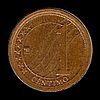 |
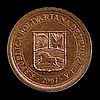
|
| 5 céntimos | Round | Copper plated steel | 17 mm | Smooth | Denomination of the coin, the eight stars and the waves representing the patterns of the national flag | Coat of Arms of Venezuela and the name of the country of emission |  |
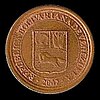
|
| 10 céntimos | Round | Nickel plated steel | 18 mm | Milled | Denomination of the coin, the eight stars and the waves representing the patterns of the national flag | Coat of Arms of Venezuela and the name of the country of emission | 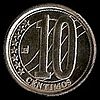 |

|
| 12,5 céntimos | Round | Nickel plated steel | 23 mm | Smooth | Denomination of the coin, the eight stars of the national flag and two palm branches | Coat of Arms of Venezuela and the name of the country of emission |  |
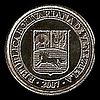
|
| 25 céntimos | Round | Nickel plated steel | 20 mm | Smooth | Denomination of the coin, the eight stars and the waves representing the patterns of the national flag | Coat of Arms of Venezuela and the name of the country of emission | 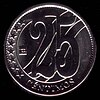 |

|
| 50 céntimos | Round | Nickel plated steel | 22 mm | Smooth and Milled | Denomination of the coin, the eight stars and the waves representing the patterns of the national flag | Coat of Arms of Venezuela and the name of the country of emission |  |
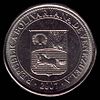
|
| Bs. 1 | Round | Copper-Nickel center, Brass ring | 24 mm | Smooth 'BCV1' | Effigy of the Liberator Simón Bolívar, waves representing the patterns of the national flag | Denomination of the coin, the eight stars and the waves representing the patterns of the national flag, the Coat of Arms of Venezuela and the name of the country of emission | 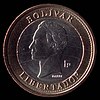 |
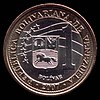
|
Banknotes
Bolívar
In 1940, the Banco Central de Venezuela began issuing paper money, introducing by 1945 denominations of 10, 20, 50, 100 and 500 bolívares. 5 bolívar notes were issued between 1966 and 1974, when they were replaced by coins. In 1989, notes for 1, 2 and 5 bolívares were issued.
As inflation took hold, higher denominations of banknotes started being introduced: 1,000 bolívares in 1991, 2,000 and 5,000 bolívares in 1994, and 10,000, 20,000 and 50,000 bolívares in 1998. The first 20,000 banknotes were made in a green color similar to the one of the 2,000 banknotes, which caused confusion, and new banknotes were made in the new olive green color.
The following is a list of a former Venezuelan bolívar banknotes.
| Pre-1998 series banknotes (from various series) | |||||
|---|---|---|---|---|---|
| Image | Denomination | Emission Year | Obverse | Reverse | |
| 500 bolívares | 1981 | Simón Bolívar | A branch of orchids | ||
| 1,000 bolívares | 1991 | Simón Bolívar | Signing of the Venezuelan Declaration of Independence | ||
| 2,000 bolívares | 1994 | Antonio José de Sucre | The Battle of Junín | ||
| 5,000 bolívares | 1994 | Simón Bolívar and his coat of arms | A reproduction of the painting El 19 de Abril de 1810 by Juan Lovera | ||
| [3] | [4] | 10,000 bolívares | 1998 | ||
| 1998-2007 Series | |||||
| 1,000 bolívares | 1998 | Simón Bolívar | A branch of orchids, the Cerro El Ávila, and the Panteón Nacional | ||
| 2,000 bolívares | 1998 | Andrés Bello | A picture of frailejones and a view of the Pico Bolívar | ||
| 5,000 bolívares | 2000 | Francisco de Miranda | Picture of two angelfishes and a panorama of the Guri Dam. | ||
| 10,000 bolívares | 2000 | Antonio José de Sucre | A Marpesia petreus butterfly and the Supreme Tribunal of Justice | ||
| 20,000 bolívares | 2000 | Simón Rodríguez and the Angel Falls in the background | A Blue-and-yellow Macaw and the Angel Falls | ||
| 50,000 bolívares | 1998 | José María Vargas | The Student's Square in the Ciudad Universitaria and the clock in it | ||
Bolívar fuerte
Banknotes are in denominations of 2, 5, 10, 20, 50 and 100 bolívares.
| 2008 Series | |||||
|---|---|---|---|---|---|
| Image | Denomination | Emission Year | Obverse | Reverse | |
| 2 bolívares | 2008 | Francisco de Miranda | Orinoco River Dolphins with Coro Dunes in background | ||
| 5 bolívares | 2008 | Pedro Camejo | Giant Armadillo with plains in background | ||
| 10 bolívares | 2008 | Cacique Guaicaipuro | American Harpy Eagle with Ucaima Falls in background | ||
| 20 bolívares | 2008 | Luisa Cáceres de Arismendi | Hawksbill turtle with Macanao Mountain in background | ||
| 50 bolívares | 2008 | Simón Rodríguez | Spectacled Bear with Laguna Santo Cristo in background | ||
| 100 bolívares | 2008 | Simón Bolívar | Red Siskin with Cerro El Ávila in background | ||
| Current VEF exchange rates | |
|---|---|
| From Google Finance: | AUD CAD CHF CNY EUR GBP HKD JPY USD |
| From Yahoo! Finance: | AUD CAD CHF CNY EUR GBP HKD JPY USD |
| From XE.com: | AUD CAD CHF CNY EUR GBP HKD JPY USD |
| From OANDA: | AUD CAD CHF CNY EUR GBP HKD JPY USD |
See also
References
- ^ a b c d e Banco Central de Venezuela. "B.C.V. Bolívar Fuerte." Accessed 26 Feb 2011.
- ^ Rachael Boothroyd (May 4, 2011). "Venezuela's Inflation Rate Down from 2010". Venezuelanalysis.
- ^ a b c Simon Romero (February 9, 2008). "In Venezuela, Faith in Chávez Starts to Wane". New York Times.
- ^ Rueda, Jorge (2008-01-01). "Venezuela Introduces New Currency". ABC News. Retrieved 2008-02-04. [dead link]
- ^ The Economist, [1]
- ^ CADIVI, Sistema Cambiario
- ^ a b The Scotsman. Edinburgh http://news.scotsman.com/latest.cfm?id=257062007.
{{cite news}}: Missing or empty|title=(help) [dead link] - ^ tevision advertisements [2] for the new currency repeatedly use "fuerte" as meaning "strong" such as in "Una economía fuerte" (a strong economy) and "¡Aquí hay fuerza!" (There's strength in this!)
- ^ Rueda, Jorge (2008-01-01). "Venezuela cuts three zeros off bolivar currency". Reuters. Retrieved 2008-02-04.
- ^ Numismatic Catalog of Venezuela. "Coins in Pesos Fuerte". Retrieved 2008-02-04.
- ^ "Venezuela will slash value of currency, the bolivar". BBC. 2010-01-09. Retrieved 2010-01-09.
- ^ Numismatic Catalog of Venezuela. "Coins from Venezuela : 1000 Bolívares - Design B, Type A". Retrieved 2011-01-07.
- Krause, Chester L.; Clifford Mishler (1991). Standard Catalog of World Coins: 1801–1991 (18th ed.). Krause Publications. ISBN 0873411501.
- Pick, Albert (1994). Standard Catalog of World Paper Money: General Issues. Colin R. Bruce II and Neil Shafer (editors) (7th ed.). Krause Publications. ISBN 0-87341-207-9.
